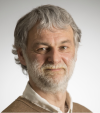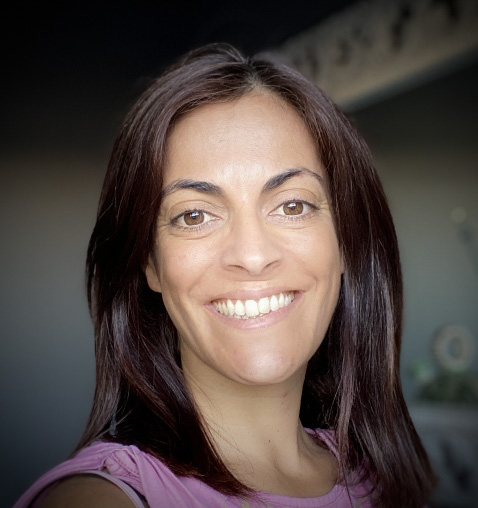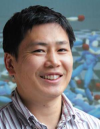Transdiciplinary workshop on human motion analysis and synthesis
-
2015 June 26, Inria Rennes, Markov Room
Program
9h00 - 9h15 Introduction, Julien Pettré
9h15 - 11h15 Session 1
9h15 - 9h55 How does the sole geometry of goal oriented locomotor trajectories reveal the role of perception?

Jean-Paul Laumond, LAAS-CNRS, Toulouse, France
Summary: Goal oriented human locomotor trajectories live in the 3-dimensional
space R2xS1. From a control viewpoint, the dimension of the control
space is spanned by three vector fields: respectiveley forward,
crab-steering mode and rotation velocities. At first glance, the
geometry of the locomotor trajectories may be explained by an optimality
principle whose cost function is expressed only in that vector field
basis. The hypothesis may be explored by inverse optimal control
techniques [1]. However such an hypothesis necessary implies some
symmetry properties. We discuss an experimental protocol that
invalidates the statement [2]: goal oriented locomotor trajectories are
not symmetric in R2xS1. We then show how another cost function that
includes the bearing angle minimization accounts for the geometry of the
paths.
[1] K. Mombaur, A. Truong, J.P. Laumond, From human
to humanoid locomotion : an inverse optimal control approach, Autonomous
Robots, Vol. 28, N. 3, 2010.
[2]M. Sreenivasa, K. Mombaur,
J.P. Laumond, Walking paths to and from a goal differ : On the role of
bearing angle in the formation of
human locomotion paths. PlosOne, Vol. 10(4), 2015
Bio: Jean-Paul Laumond,
IEEE Fellow, is a roboticist. He is Directeur de Recherche at
LAAS-CNRS (team Gepetto) in Toulouse, France. His research is devoted to
robot motion. In the 90's, he has been the
coordinator of two European Esprit projects PROMotion (Planning RObot
Motion) and MOLOG (Motion for Logistics), both dedicated to robot motion
planning and control. In the early 2000's he created and managed Kineo
CAM, a spin-off company from LAAS-CNRS devoted to develop and market
motion planning technology. Kineo CAM was awarded the French Research
Ministery prize for innovation and enterprise in 2000 and the third
IEEE-IFR prize for Innovation and Entrepreneurship in Robotics and
Automation in 2005. Siemens acquired Kineo CAM in 2012. In 2006, he
launched the research team Gepetto dedicated to Human Motion studies
along three perspectives: artificial motion for humanoid robots, virtual
motion for digital actors and mannequins, and natural motions of human
beings. He teaches Robotics at Ecole Normale
Supérieure in Paris. His works are published in Robotics,
Computer Science, Automatic Control and recently in Neurosciences. He
has been the 2011-2012 recipient of the Chaire Innovation technologique
Liliane Bettencourt at Collège de France in Paris. His current
project Actanthrope (ERC-ADG 340050) is devoted to the computational
foundations of anthropomorphic action.
http://homepages.laas.fr/jpl/
9h55 - 10h35 Behavioral Dynamics
Approach to Pedestrian and Crowd Behavior

William H. Warren, Brown University, Providence, USA
Summary: Behavioral dynamics seeks to explain
stable, adaptive behavior as emerging from the interaction between an agent and
their environment, under physical and informational constraints [1]. To
this end, we are developing a perceptually-grounded model of human locomotor
behavior to account for pedestrian and crowd dynamics.
Taking a
local-to-global approach, we derive a
pedestrian model based on human experiments in VR, including components for
steering, obstacle avoidance, interception, and pedestrian interactions such as
following [2-4]. Elementary behaviors are modeled as nonlinear
dynamical systems, which are linearly combined to generate more complex
behavior. Multi-agent simulations are
then used to predict global patterns of crowd behavior. Currently, we are investigating the local
coupling between a pedestrian and multiple neighbors in a virtual crowd , which
appears to be additive and to decay linearly with distance, yielding a metric
neighborhood.
Reciprocally,
taking a global-to-local approach, we
collect motion-capture data on human crowds in key scenarios. Patterns of crowd behavior are analyzed to
estimate the local coupling and test the model.
Key scenarios such as Swarm,
in which 20 participants veer left and right while staying together as a group,
and Counterflow, in which two groups
pass through each other, can be simulated with just a few model components.
The
results support the view that pedestrian and crowd behavior emerges from local
interactions, without internal models or plans, consistent with principles of
self-organization.
1. Warren W.H. 2006 The
dynamics of perception and action. Psychological
Review 113, 358-389.
2. Warren W.H., Fajen
B.R. 2008 Behavioral dynamics of visually-guided locomotion. In Coordination: Neural, behavioral, and social
dynamics (eds. Fuchs A., Jirsa V.). Heidelberg, Springer.
3. Rio K., Rhea C.,
Warren W.H. 2014 Follow the leader: Visual control of speed in pedestrian
following. Journal of Vision 14(2), 4:1-16.
4. Dachner G., Warren
W.H. 2014 Behavioral dynamics of heading alignment in pedestrian following. Transportation Research Procedia 2, 69-76.
Bio: William Warren is Chancellor’s Professor of
Cognitive, Linguistic, and Psychological Sciences and Director of the Virtual
Environment Navigation Lab (VENLab) at Brown University. He earned his undergraduate degree at
Hampshire College (1976), a Ph.D. in Experimental Psychology from the
University of Connecticut (1982), did post-doctoral work at the University of
Edinburgh (1983), and has been a professor at Brown ever since, including
serving as department chair (2002-10). He
uses virtual reality techniques to investigate the visual control of human
action within a dynamical systems framework, with funding from NIH, NSF, and the
VA. Warren is author of over 100 research articles and chapters, the editor of
two volumes, and the recipient of a Fulbright Research
Fellowship, an NIH Research Career Development Award, and Brown's Elizabeth
Leduc Teaching Award for Excellence in the Life Sciences.
http://www.brown.edu/Departments/CLPS/people/william-warren
10h35 - 11h15 Visual servoing, an intuitive motion control approach

Francois Chaumette, Inria, Rennes, France
Summary: The talk will present the basic aspects of visual servoing, that is,
a control scheme in closed loop with respect to visual data for
controlling the motion of robotics systems. Applications in humanoid
robotics will be also described.
Bio: François Chaumette, IEEE Fellow, is an Inria Senior Scientist, currently head of the Lagadic group at Irisa in Rennes.
http://www.irisa.fr/lagadic/team/Francois.Chaumette-eng.html
11h15 - 12h15 Demonstrations @ Immersia 3
12h15 - 13h45 Lunch (Salle Sein)
13h45 - 14h25 Session 2
13h45 - 14h25 Crowds for real-time applications

Nuria Pelechano, Barcelona University, Spain
Summary: The
simulation of large
numbers of autonomous avatars can be a big challenge for
real-time
applications. In this
talk I will cover some
of the most relevant areas regarding this topic including local
movement,
planning, navigation meshes and synthesis of animations. Local
movement can be
achieved through a combination of physical forces and rules
given by
psychological and geometrical factors. At the higher level,
local movement
needs to be driven by a navigation technique, such as
multi-domain planning
based on different representations for space, time and actions.
By using plans
in one domain to focus the search in finer domains, we can speed
up the overall
process of having agents navigating complex virtual
environments. This talk will
briefly cover how navigation meshes can be automatically
generated for path finding
with the NEOGEN system. Finally, I will describe techniques to
synthesize
animations based on foot step trajectories for those scenarios
that may require
careful foot positioning.
Bio: Nuria Pelechano is an
Associate
Professor at the Universitat Politecnica de Catalunya. She
obtained her Engineering
degree from the Universitat de Valencia, her Masters degree from
the University
College London, and her PhD from the University of Pennsylvania
as a Fulbright
Scholar in 2006. During her post-doc she worked with the
Architecture Department
at UPenn in several technology transfer projects on crowd
evacuation. Nuria is the
co-author of the books “Virtual Crowds: Methods, Simulation, and
Control. Morgan
& Claypool Publishers. 2008.” and “Virtual Crowds: Steps
toward Behavioral
Realism, Morgan & Claypool Publishers. August 2015”. Nuria has over 30
publications in journals and
international conferences on Computer Graphics and Animation.
She has
participated in projects funded by the EU, the Spanish
Government, and several
USA institutions. Her research interests include simulation,
animation and
rendering of crowds, generation of navigation meshes, real-time
3D graphics,
and human-avatar interaction in virtual environments.
http://www.cs.upc.edu/~npelechano/
14h25 - 15h05 Assessing Agency and Self-Location in Embodied Interactions

Ronan Boulic, EPFL, Switzerland
Summary : the talk will present recent activities of the Immersive
Interaction research Group on real-time interaction with virtual
environment through full-body movements. We focus primarily on ensuring
the Sense of Agency , i.e. "making the user feel to be in control of the
movement of the displayed avatar", but we also explore the importance of
the Sense of Self-Location, i.e. "real and virtual bodies coincide due
to a first person viewpoint". The intended applications are training in
virtual environments, rehabilitation and performance animation.
Bio : Ronan Boulic is a Senior Scientist and PhD Advisor at the EPFL (Ecole
Polytechnique Fédérale de Lausanne). He currently leads the Immersive
Interaction research group (IIG) from the School of Computer and
Communication Sciences. He received the PhD degree in Computer Science
in 1986 from the University of Rennes, France, and the Habilitation
degree in Computer Science from the University of Grenoble, France, in
1995. He is senior member of IEEE and of ACM, and member of
Eurographics. Ronan Boulic has co-authored more than 140 refereed
publications, including 36 in ISI-indexed journals, and contributed to
10 books. He was paper co-chair of the Eurographics/SIGGRAPH Symposium
on Computer Animation 2004 in Grenoble, and general chair of the same
symposium in 2012 in Lausanne. He was also paper co-chair of the joint
Virtual Reality conference JVRC in Madrid in 2012. He has served on over
50 program committees of key conferences in computer graphics, computer
animation and virtual Reality. He is Associate Editor of Wiley CAVW,
Elsevier Computers & Graphics and IEEE TVCG (2011-14).
http://iig.epfl.ch/page-40267-en.html
15h05 - 15h45 Motion synthesis and planning by spatial relationship descriptors

Taku Komura, Edinbourgh University, Scotland
Summary: In the area of
computer animation and robotics, synthesizing movements such as
tangling limbs, passing through constrained environments, wrapping and
winding cloth or ropes around objects, are considered as difficult
problems. Making use of descriptors based on the spatial relationships
is essential for synthesizing such movements. In this talk, I
will describe about the research done in our group for synthesizing
complex movements by using spatial relationship descriptors. These
include synthesizing winding and knotting movements using Gauss linking
numbers, synthesizing wrapping movements using electrostatic flux,
retargeting movements using Laplacian coordinates, and classifying and
recognizing scenes using medial axis. I will further discuss about our
recent work about abstracting the geometry of the environment and plan
the movements in the abstracted space.
Bio: Taku Komura is a Reader at
the Institute of Perception, Action and Behavior, School of
Informatics, University of Edinburgh. He is also awarded a
Royal Society Industry Fellowship to work in collaboration with Disney
Research. As the group leader of the Computer Animation and
Visualization Unit, his research has focused on data-driven character
animation, physically-based character animation, crowd simulation,
cloth animation, geometry processing and robotics.
http://homepages.inf.ed.ac.uk/tkomura/
15h45 - 16h25 Guiding style in optimized control of character locomotion, balance, and
multi-finger manipulation

Paul Kry, McGill University, Montreal, Canada
Summary : Control for physically based characters presents a challenging task
because it requires not only the management of the functional aspects
that lead to the successful completion of the desired task, but also the
resulting movement must be visually appealing and meet the quality
requirements of the application. Crafting controllers to generate
desirable behaviours is difficult because the specification of the final
outcome is indirect and often at odds with the functional control of the
task. In this talk I will present methods for optimizing controllers
where there also exists a mechanism for guiding the style of the motion.
I present and discuss a collection of examples involving locomotion,
balance, and multi-finger manipulation.
Bio : Paul G. Kry is an associate professor in the School of Computer Science
at McGill University, where heads the Computer Animation and Interaction
Capture Laboratory. Paul G. Kry received his B.Math. in computer
science with electrical engineering electives in 1997 from the
University of Waterloo, and his M.Sc. and Ph.D. in computer science from
the University of British Columbia in 2000 and 2005. He spent time as a
visitor at Rutgers during most of his Ph.D., and did postdoctoral work
at INRIA Rhône Alpes and the LNRS at Université René Descartes. His
research interests are in physically based animation, including
deformation, contact, motion editing, and simulated control of
locomotion, grasping, and balance. He co-chaired ACM/EG Symposium on
Computer Animation in 2012, Graphics Interface in 2014, and served on
numerous program committees, including ACM SIGGRAPH, Eurographics,
ACM/EG Symposium on Computer Animation, Pacific Graphics, and Graphics
Interface. He is currently the president of the Canadian Human Computer
Communications Society, the organization which sponsors the annual
Graphics Interface conference.
http://www.cs.mcgill.ca/~kry/
16h25 - 17h00 Conclusion, Julien Pettré




